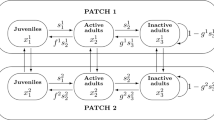Abstract
In this work we consider a structured population with groups and subgroups of individuals. The intra-group dynamics is assumed to be fast in comparison with the inter-group dynamics. We study linear discrete models where the slow dynamics is represented by a single matrix and the fast dynamics is described by means of the first k terms of a converging sequence of different matrices. The number k can be interpreted as the ratio between the two time scales.
The aim of this work is to extend aggregation techniques to the case of fast changing environments. The main idea of aggregation is to build up a new system, with lower dimension, that summarizes the information concerning the fast process. This "aggregated" system provides essential information on the original one. It is shown that the asymptotic behavior of the original system can be approximated by the asymptotic behavior of the aggregated system when the ratio between the two time scales is large enough.
We present an example of an age structured population in a patchy environment. The migration process is assumed to be fast in comparison with the demographic process. Numerical simulations illustrate that the asymptotic growth rate and the stable age distribution of the population in the original and the aggregated systems are getting closer as the ratio k increases.
Similar content being viewed by others
REFERENCES
Auger, P. and R. Bravo de la Parra (2000). Methods of aggregation of variables in population dynamics. Comptes Rendus de l'Académie des Sciences, Sciences de la vie 323: 665-674.
Auger, P. and J.C. Poggiale (1996a). Emergence of population growth models: fast migration and slow growth. Journal of Theoretical Biology 182: 99-108.
Auger, P. and J.C. Poggiale (1996b). Aggregation and emergence in hierarchically organized systems: population dynamics. Acta Biotheoretica 44: 301-316.
Auger, P. and R. Roussarie (1994). Complex ecological models with simple dynamics: From individuals to populations. Acta Biotheoretica 42: 111-136.
Berman, A. and R.J. Plemmons (1979). Nonnegative matrices in the mathematical sciences. Academic Press, San Diego.
Bravo de la Parra, R. and E. Sinchez (1998). Aggregation methods in population dynamics discrete models. Mathematical and Computer Modelling 27: 23-39.
Bravo de la Parra, R., E. Sinchez, O. Arino and P. Auger (1999). Discrete model with density dependent fast migration. Mathematical Biosciences 157: 91-109.
Caswell, H. (2001). Matrix population models. Sinauer Associates Inc. Sunderland, Massachusetts.
Charlesworth, B. (1994). Evolution in age-structured populations. Cambridge University Press, Cambridge. 306pp.
Cohen, J.E. (1979). Ergodic theorems in demography. Bulletin of the American Mathematical Society 1: 275-295.
Hajnal, J. (1976). On products of non-negative matrices. Mathematical Proceedings of the Cambridge Philosophical Society 79: 521-530.
Iwasa, Y., V. Andreasen and S.A. Levin (1987). Aggregation in model ecosystems I. Perfect aggregation. Ecological Modelling 37: 287-302.
Iwasa, Y., S.A. Levin and V. Andreasen (1989). Aggregation in model ecosystems II. Approximate aggregation. IMA Journal of Mathematics Applied in Medicine and Biology 6: 1-23.
Poggiale, J.C., and P. Auger, (1995). Fast oscillating migrations in a prey-predator model, Mathematical Models and Methods in Applied Sciences 6: 217-226.
Sanchez, E., R. Bravo and P. Auger (1995). Linear discrete models with different time scales. Acta Biotheoretica 43: 465-479.
Sanz, L. and R. Bravo de la Parra (1998). Variables aggregation in time varying discrete systems. Acta Biotheoretica 46: 273-297.
Sanz, L. and R. Bravo de la Parra (1999). Variables aggregation in a time discrete linear model. Mathematical Biosciences 157: 111-146.
Sanz, L. and R. Bravo de la Parra (2000). Time scales in stochastic multiregional models. Nonlinear Analysis: Real World Applications 1: 89-122.
Sanz, L. and R. Bravo de la Parra (2001). Time scales in a non autonomous linear discrete model. Mathematical Models and Methods in Applied Sciences. (accepted)
Seneta, E. (1981). Non-negative matrices and Markov chains. Springer Verlag, New York.
Simon, H. A. and A. Ando (1961). Aggregation of variables in dynamic systems. Econometrica 29: 111-135.
Stewart, G.W. and J.I-Guang Sun (1990). Matrix perturbation theory. Academic Press, San Diego.
Author information
Authors and Affiliations
Rights and permissions
About this article
Cite this article
Blasco, Á., Sanz, L., Auger, P. et al. Linear Discrete Population Models with Two Time Scales in Fast Changing Environments I: Autonomous Case. Acta Biotheor 49, 261–276 (2001). https://doi.org/10.1023/A:1014274409765
Issue Date:
DOI: https://doi.org/10.1023/A:1014274409765




